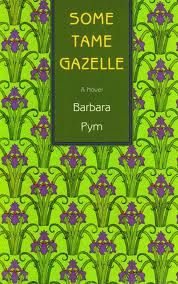 I have finished reading one of the two books that Thomas of My Porch sent me. You done good, Thomas, I found it charming and funny. Pym is not entirely different from another Barbara I recently discovered, through Stuck in a Book: Barbara Comyns, whose Who Was Changed and Who Was Dead I really enjoyed. Simon, Thomas, anyone, if you can help me come up with a better genre tag for these ladies than “misc fiction,” I’d be obliged. Do these count as “domestic fiction” or whatever they call Jane Austen? Sorry, I’ll get on with it…
I have finished reading one of the two books that Thomas of My Porch sent me. You done good, Thomas, I found it charming and funny. Pym is not entirely different from another Barbara I recently discovered, through Stuck in a Book: Barbara Comyns, whose Who Was Changed and Who Was Dead I really enjoyed. Simon, Thomas, anyone, if you can help me come up with a better genre tag for these ladies than “misc fiction,” I’d be obliged. Do these count as “domestic fiction” or whatever they call Jane Austen? Sorry, I’ll get on with it…
Some Tame Gazelle is the story of two spinster sisters, Belinda and Harriet, in a little English village in the 1950’s or thereabouts. We get the story from Belinda’s perspective primarily. She’s the dowdier and more humble of the two sisters, and her day-to-day life revolves, perhaps more than she realizes, around the local Archdeacon, who she knows and still loves as Henry from their school days. Henry is married, of course, and she resignedly sighs and gently envies his difficult wife Agatha, with whom he does not seem entirely happy, and alternately resolves to be a friend to her. Harriet, on the other hand, is still regularly refusing marriage proposals (mostly from the same man, Ricardo, an Italian count who Belinda rather wishes she would marry). Harriet is a bit sillier and prouder than her sister, but they depend on each other and are very much settled in their life together.
We read about this little village, where the sisters have tea, buy groceries, attend church, and help out with church functions. Where Belinda is devoted to the Archdeacon and worries over what garments she can appropriately knit for him, Harriet attaches herself to one curate after another and teases Ricardo and criticizes Belinda’s beloved Henry. Day follows day.
Sort of like what I said about the Comyns novel, this is a quiet book; there aren’t loud noises; you don’t jump in your seat. But my, is it ever quietly funny. Pym is compared to Austen, which I guess makes sense, but they’re not so similar you’d confuse them or anything. Part of this I suppose is the subject matter, that is, spinster ladies vs young women chasing marriageable men of independent wealth. (And I haven’t done my Pym research so don’t know if this is her standard subject material.) But I suppose the tone is comparable to Austen: people are so confined by custom and what the neighbors might think that they do silly things, and worry about silly things, and certain gentlemen do even sillier things that the women make excuses for. It’s a humor of quiet, respectable absurdity.
It also has in common with Austen, a female preoccupation with marriage. I don’t want to give anything away, but there are marriage proposals and there are weddings (okay, only one is onscreen), and there is much agonizing over marriage. There is also some rather blasphemous talk of spouse-switching – all completely theoretical and private, of course.
This book is set firmly in religion; most of the main characters are clergy, or obsessed with a member of the clergy, and all are church workers. This was a little foreign for me, someone with no church or religion in her life (don’t pity me, I’m very happy this way, and I don’t like being judged either, thanks) but I think I followed along okay. It’s not “Christian fiction” in any way; the church is just the backdrop. If anything, the church is an object of some merriment too, since the clergy tend to behave at least as ridiculously as anyone else.
Without getting too spoilery, I’m going to stop here in discussion of plot, but I want to note the title. The book opens with a Thomas Haynes Bayly quotation:
Some tame gazelle, or some gentle dove:
Something to love, oh, something to love!
Which perhaps tells us what this book is “about” better than anything.
If you are okay with the spoilers and/or have read this book, highlight the white text below.
One of my favorite things about this book is that it came full circle and we ended up right exactly back where we started. I was worried along with Belinda that one (or the other!) of the sisters was going to accept a marriage proposal, but I was much happier ending with Harriet preparing to dote on a new curate, and back again to the first line. So this is another book in which not much happens – but it’s surprising how satisfying that can be.
Thomas! You are wonderful! Thanks so much. Can’t wait to get into The Home-Maker.
Filed under: book reviews | Tagged: domestic fiction, misc fiction |







Yay. I am so glad you liked this one. My favorite scene is the one with the worm in the cauliflower cheese.
Thanks for reminding me! That was indeed special! I can remember that making my skin crawl when I read it, ew.
[…] Some Tame Gazelle, Barbara Pym. Fiction. […]
[…] would like to thank Thomas at My Porch, again, for sending me this book along with the also-lovely Some Tame Gazelle. (This was because I have cute dogs. Lucky me!) Thank you, Thomas! You did so splendidly selecting […]
[…] Some Tame Gazelle*, Barbara Pym. Fiction. […]